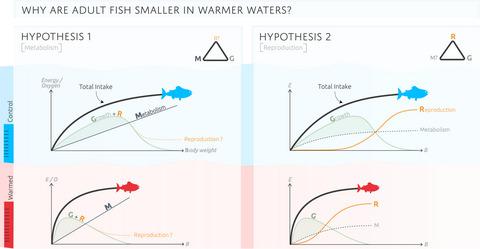当前位置:
X-MOL 学术
›
Ecol. Lett.
›
论文详情
Our official English website, www.x-mol.net, welcomes your
feedback! (Note: you will need to create a separate account there.)
Smaller adult fish size in warmer water is not explained by elevated metabolism
Ecology Letters ( IF 7.6 ) Pub Date : 2022-03-09 , DOI: 10.1111/ele.13989 Henry F Wootton 1 , John R Morrongiello 1 , Thomas Schmitt 1 , Asta Audzijonyte 2, 3
Ecology Letters ( IF 7.6 ) Pub Date : 2022-03-09 , DOI: 10.1111/ele.13989 Henry F Wootton 1 , John R Morrongiello 1 , Thomas Schmitt 1 , Asta Audzijonyte 2, 3
Affiliation

|
Fish and other ectotherms living in warmer waters often grow faster as juveniles, mature earlier, but become smaller adults. Known as the temperature-size rule (TSR), this pattern is commonly attributed to higher metabolism in warmer waters, leaving fewer resources for growth. An alternative explanation focuses on growth and reproduction trade-offs across temperatures. We tested these hypotheses by measuring growth, maturation, metabolism and reproductive allocation from zebrafish populations kept at 26 and 30°C across six generations. Zebrafish growth and maturation followed TSR expectations but were not explained by baseline metabolic rate, which converged between temperature treatments after a few generations. Rather, we found that females at 30°C allocated more to reproduction, especially when maturing at the smallest sizes. We show that elevated temperatures do not necessarily increase baseline metabolism if sufficient acclimation is allowed and call for an urgent revision of modelling assumptions used to predict population and ecosystem responses to warming.
中文翻译:

新陈代谢升高不能解释温暖水域中较小的成年鱼体型
生活在温暖水域的鱼类和其他变温动物通常在幼鱼时生长得更快,成熟得更早,但成年后会变得更小。这种模式被称为温度大小规则 (TSR),通常归因于在较温暖的水域中较高的新陈代谢,留下较少的生长资源。另一种解释侧重于不同温度下的生长和繁殖权衡。我们通过测量保持在 26 和 30°C 六代的斑马鱼种群的生长、成熟、新陈代谢和生殖分配来检验这些假设。斑马鱼的生长和成熟遵循 TSR 预期,但不能用基线代谢率来解释,在几代后温度处理之间收敛。相反,我们发现在 30°C 时雌性会更多地分配给繁殖,尤其是在以最小尺寸成熟时。
更新日期:2022-03-09
中文翻译:

新陈代谢升高不能解释温暖水域中较小的成年鱼体型
生活在温暖水域的鱼类和其他变温动物通常在幼鱼时生长得更快,成熟得更早,但成年后会变得更小。这种模式被称为温度大小规则 (TSR),通常归因于在较温暖的水域中较高的新陈代谢,留下较少的生长资源。另一种解释侧重于不同温度下的生长和繁殖权衡。我们通过测量保持在 26 和 30°C 六代的斑马鱼种群的生长、成熟、新陈代谢和生殖分配来检验这些假设。斑马鱼的生长和成熟遵循 TSR 预期,但不能用基线代谢率来解释,在几代后温度处理之间收敛。相反,我们发现在 30°C 时雌性会更多地分配给繁殖,尤其是在以最小尺寸成熟时。











































 京公网安备 11010802027423号
京公网安备 11010802027423号